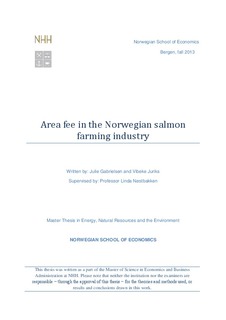Area fee in the Norwegian salmon farming industry
Abstract
A discussion on a new tax, an area fee, for the Norwegian salmon industry has been on-going for several years. This thesis examines which tax benefits the industry and the host municipalities the most. To investigate this, three taxes are compared by a set of evaluation criteria. The three chosen taxes are: tax on quantity, tax on revenue and tax on area used.
To conduct the thesis, existing reports and papers are used extensively in addition to economic theory and an industry specific knowledge. The industry is highly regulated with restricted production sites and limited production licenses.
Tax on revenue is preferred among producers as it varies with production and market trends, while municipalities prefer a stable tax income as from tax on area used. Taking every evaluation criteria into account, we find tax on individual revenue to be the most suitable of the analysed taxes.
The thesis gives the reader a brief introduction of the industry and relevant regulations for the analysis. Thereafter, the analysis begins by introducing seven defined evaluation criteria and a stylized model. All three taxes are analysed in compliance with the model and the set criteria. At the end of the thesis we briefly discuss how to implement a tax before presenting our conclusion.
